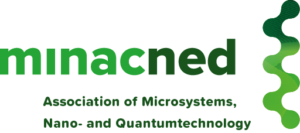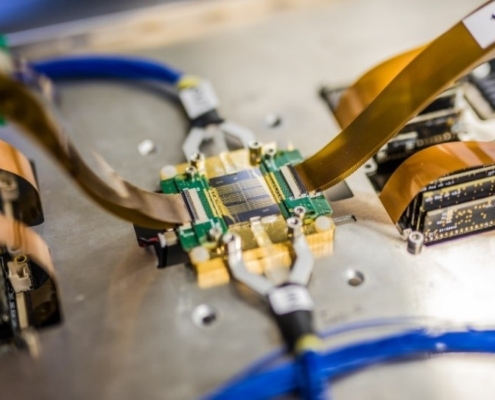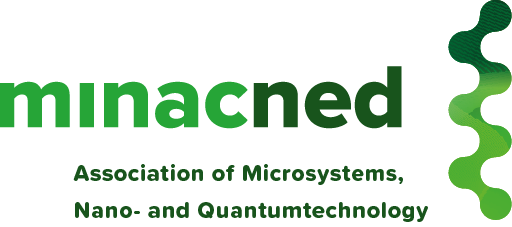By Maarten Buijs, from PhotonDelta
What are Photonic Integrated Circuits?
Electronics versus Photonics
Where electronics deals with the control of electrons on a chip, photonics does the same with photons. It covers the physics, engineering, technology and applications of light (photon) generation, detection, and manipulation through emission, transmission, modulation, signal processing, switching, amplification, and sensing. Photons travel at the speed of light and move through certain materials with almost no loss. Photonics can have a very high frequency range, resulting in high data throughput at a fraction of the energy costs of electronic circuits.
Adopting photons to carry signals over low-loss optical fiber transmission lines, and so replacing coaxial cables in telecommunication systems, led to the first significant business where photonics was applied. [1]
Integrated Photonics
Just as electronic functions can be integrated into an electronic integrated circuit (IC), photonic functions can also be integrated into a photonic integrated circuit (PIC). Building on the success of silicon (Si) as the basis of the IC revolution, silicon photonics (SiPh) has become an important part of the integrated photonics development.
Si is transparent to infrared light with wavelengths above about 1.1 micrometers, so also to the 1.55 micrometer wavelength used by most fiber optic telecommunication systems. In addition, it has a very high refractive index, of about 3.5, much higher than that of silicon oxide (1.5), which allows strong confinement of light in Si structures embedded in silicon oxide (waveguides). These properties make Si well suited for usage in telecom. However, Si does not allow direct generation of light. Indium phosphide (InP) does not have this restriction, because it has a direct semiconductor bandgap. So, PICs based on the InP material platform became commercially very successful; InP integrated photonics has been a critical enabler for modern telecommunications.
A photonic circuit. Image: LioniX International
InP allows for the integration of active and passive elements like high-performance amplifiers, lasers, modulators, and detectors in combination with interferometers within one chip in the 1.1 – 1.6 mm spectral window. This leads to performance advances, energy savings and cost reductions,[2] which has allowed InP integrated photonics to revolutionize data communications, precision metrology (for example LIDAR in autonomous vehicles), spectrometry, and imaging. Current state-of-the-art devices integrate hundreds of functions onto a single chip.
Another material system making strong inroads into integrated photonics is silicon nitride (SiN). It excels at passive light processing in the visible, near-infrared (NIR) and IR range thanks to among others its very low light intensity loss in the waveguide, small bend radii and adjustable polarization. Waveguides guide light on integrated devices but can also perform guiding, coupling, switching, splitting, multiplexing, and demultiplexing of optical signals.
By integrating SiN PICs with active components based on other technologies like InP, high performance photonics Systems-in-Package devices can be manufactured.
Biosensors based on the SiN platform explained
One of the photonic industries key application areas concerns biosensors based integrated photonic circuits. SiN PICs are in particular very well suited for the detection of biological molecules. They work in a very wide wavelength range from visible to near-infrared, avoiding the water absorption window of water and allowing fluorescence detection. Also, this wavelength range makes it easy to combine them with a cheap laser source. The small bend radii possible in SiN allow the light-constraining waveguide to be ‘’rolled up” on the surface, creating a very long light path. In combination with the ultra-low loss of propagating light in SiN, this leads to a long interaction time of the light with biomolecules that are in the vicinity of the surface. Biosensors based on SiN PICs are thus highly sensitive. A very low detection limit can be achieved by using self-referencing optical structures which eliminate sources of noise like temperature variations.
Biosensors are or will be applied in a multitude of areas, like towards health-related targets (e.g. glucose monitoring in diabetes patients, early detection of the onset of cancer or of infectious diseases), environmental applications (e.g. the detection of pesticides and pollutants), and the food industry (e.g. determination of antibiotics or hormone residues in food, early detection of infectious diseases).
Benefits of photonic biosensors
Biosensors work by detecting so-called analytes, in this case, biomolecules or biomarkers, which in the case of human health care indicate whether a condition like cancer or an infection is present. Typically, the analyte is detected in a sample of bodily fluids like blood, urine, or sputum. These analytes are detected by being captured by so-called bioreceptors, which can be antibodies, nucleic acids, proteins, pathogens, or even created by biological engineering. In their turn, bioreceptors are typically bound covalently (or by the sharing of electron pairs between atoms) to the surface of the waveguide. The bioreceptors are the conjugate to a particular analyte and therefore very selective. By applying an anti-fouling layer on the non-waveguide surface of the chip, one can assure that the bioreceptors are only bound to the SiN waveguide and not to adjacent areas of the surface. This biomarker-specific attachment to the waveguide brings the biomarkers very close to the surface of the waveguide. It also implies that additional (e.g., fluorescent) labeling of the biomarker is not needed. Being able to do label-free direct detection significantly simplifies the detection workflow.
The optical working principle of the detection is based on the fact that part of light which travels through the waveguide (at very low loss in SiN) sticks out of the waveguide, to so-called evanescent field. In the case of SiN this field contains a significant part of the total light intensity. The bioreceptor – biomarker couple on the surface of the waveguide changes the effective refractive index of the waveguide. By making use of waveguide interferometers or resonators, these refractive index changes can be translated into a quantitative assessment of the biomarker.
Also, because of the low bend radii possible in SiN, these structures can be designed very compactly and many such structures can be fitted onto the surface of a single chip. By tuning the analyte deposition, different waveguide structures can be covered with different bioreceptors, called multiplexing, so that multiple biomarkers can be detected on the same chip. This can enhance the sensitivity towards either one difficult-to-detect biomarker or towards one health condition with several characteristic biomarkers. It can also be used to measure several health conditions with one single chip.
Increasing rapid point of care testing
In the past, testing of patient samples for biomarkers was centralized at large hospitals or community laboratories in order to improve cost-effectiveness, to cope with economic pressure, and to reduce health care costs. This resulted in higher effectiveness and high-quality analytical results. However, the need for a rapid turnaround time and the “permanent” availability of local general practitioners not only during the day but also on nights and weekends has increased the need for more decentralized diagnostic approaches such as the point-of-care testing (POCT) occurring at the patients’ bedside, in operation theatres, in emergency rooms, and at accident sites.[3]
The introduction of widespread point-of-care testing of patients for diagnosis as well as screening can be significantly accelerated by combining the extreme sensitivity and selectivity of the SiN biosensor technology with the possibilities to mass produce the SiN PICs with processes, technologies and equipment derived from those used to mass manufacture electronic integrated circuits. Active components like light sources (to generate the sensing light) and detectors (to register the change of the sensing light induced by the biomolecules) cannot be made out of SiN. Therefore, integration of very small and cheap commercially available light sources (e.g. Vertical-Cavity Surface-Emitting (VCSEL) lasers) and detectors needs to be done as a step in the production process of the biosensor.
How The Netherlands and PhotonDelta work on accelerating development of Integrated Photonics
With two centers of excellence covering the important technologies for integrated photonics, and a long history of successful contributions to the integrated electronics industry like ASML, NXP and ASM International, the Netherlands is uniquely positioned to play a strong role in the continuously growing area. This drive is orchestrated by PhotonDelta, a Dutch public-private partnership consisting of a cohesive cluster of companies and highly qualified knowledge institutes, set up to accelerate and reduce time to market of integrated photonics products. PhotonDelta strengthens the ecosystem from within by stimulating and facilitating co-operation amongst the integrated photonic companies and knowledge institutions, developing the common business strategy, setting goals and stimulating co-operation between partners in the Netherlands and beyond. PhotonDelta acts as a growth accelerator and so helps to amplify and scale existing companies and kickstart new ones by having access to significant funding.
Notable academic centers of excellence of photonic integrated circuits in InP are the University of California at Santa Barbara, USA, and the Eindhoven University of Technology in the Netherlands. In Eindhoven, the technology is commercialized through the company SmartPhotonics. Important European academic centers of excellence for SiN PiC technology include EPFL at Lausanne, Switzerland and the University of Twente in Enschede, the Netherlands. The technology is commercialized through the companies Lionix International in the Netherlands and Ligentec in Switzerland.
How the PhotonDelta ecosystem works on biosensors
With support from PhotonDelta, Lionix has teamed up with fellow Dutch company Surfix, who specialize in nanocoatings for life science applications and Qurin, diagnostics specialists to develop SiN PIC-based biosensors for the direct detection of the SARS-CoV-2 virus responsible for COVID-19. The group is aiming for a quick and reliable POCT that removes the need for time-consuming lab work. Two tests are under development, one that will determine if a patient is currently infected by the virus by detecting virus receptors. The second test will determine if a patient has already been infected by the virus by detecting antibodies – the proteins produced by the immune system in response to infection.
The biosensor will detect the receptors for the virus, detecting the virus directly rather than using the current common method which involves destroying the virus’s shell and looking for the presence of released genetic material. This direct detection means results can be returned with speed, possibly even with a few minutes. Both tests are expected to be readily available within 6-9 months. An important part of this initiative will be to set up the infrastructure for mass-producing very reliable disposable biosensors. The long-standing partnership between the key players in this initiative means the groundwork has already been laid for rapid product development and rollout. When successful, this initiative will not only contribute to the fight against COVID-19, but will also have established SiN PIC technology as a platform for the further roll-out of POCT for screening and diagnosis.
Conclusion
Integrated Photonics based biosensors will advance the roll-out of point-of-care diagnostics. Further development of the technology should deliver more sensitive and more accessible biosensors for rapid diagnosis. This development will be driven, in part, by strategic collaboration between industry leaders, innovators, and health care organizations.
This is one of a series of articles discussing photonics based biosensing and the work of PhotonDelta and its partners. Future articles will include reporting on the current and long-term application of the technology for tackling Covid-19 and other point of care testing applications, as well as detail PhotonDelta’s roadmap towards high volume production of disposable biosensors.
Read the original article here
Image credit Lionix International




